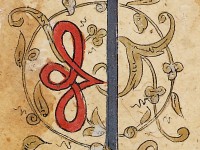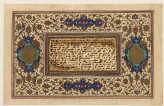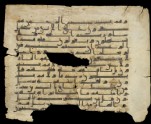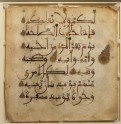Al-Qur’an al-Karim: Sacred Verses, Beautiful Pages
(from 8th Mar until 1st Jul 2012)Discover the Qur’an as a source of artistic inspiration and expression in this selection of works on paper.

- This is a visual browsing tool that maps objects in this publication, gallery or collection trail by date of creation onto a timeline.
- The circular markers indicate where objects are on the timeline.
- The size of the markers indicates the relative number of objects at that point on the timeline.
- Hover over a marker to find out which objects are represented at that point in time.
- To expand, collapse or hide the timeline, click these symbols
 found at the top right of the timeline.
found at the top right of the timeline.
- 800
- 900
- 1000
- 1100
- 1200
- 1300
- 1400
- 1500
- 1600
- 1700
- 1800
- 1900
- 2000
From oral to written revelation: The Qur’an in the first centuries of Islam
The Qur’an (from the Arabic qara’a, ‘to read aloud’ or ‘to recite’) gathers the revelations received by the Prophet Muhammad from God during his life. At first transmitted orally, the revelations were later written down by the Prophet’s closest companions, who aimed to guarantee the integrity of God’s word and standardize its reading. The resulting text, completed under the caliph Uthman (AD 644-656) and still in use today, consists of 114 sections (surat) arranged in order of descending length, and comprising a varying number of verses.
Kufic, a term describing various Arabic angular scripts, emerged very early on as the preferred hand for copying the Qur'an, and continued to be so until the early 12th century. Titles were also added to the sections and the whole text was divided into parts (most commonly 4, 7, and 30) so that its full recitation could be divided over an equivalent number of days. While headings and divisions helped the believer to navigate the text, neither of them were part of the original revelation. For this reason, scribes and illuminators marked them in different colours and scripts, a practice that gradually aestheticized the holy book and transformed it into an attractive object to behold.
Notice
Objects from past exhibitions may have now returned to our stores or a lender. Click into an individual object record to confirm whether or not an object is currently on display. Our object location data is usually updated on a monthly basis, so please contact the Jameel Study Centre if you are planning to visit the museum to see a particular Eastern Art object.
© 2013 University of Oxford - Ashmolean Museum





